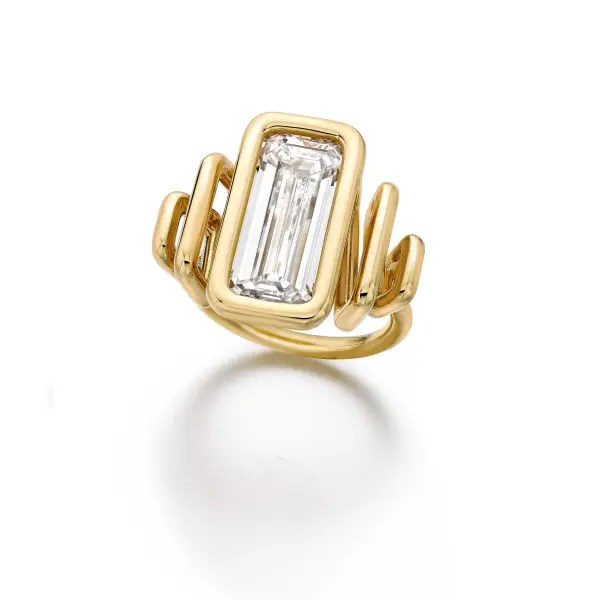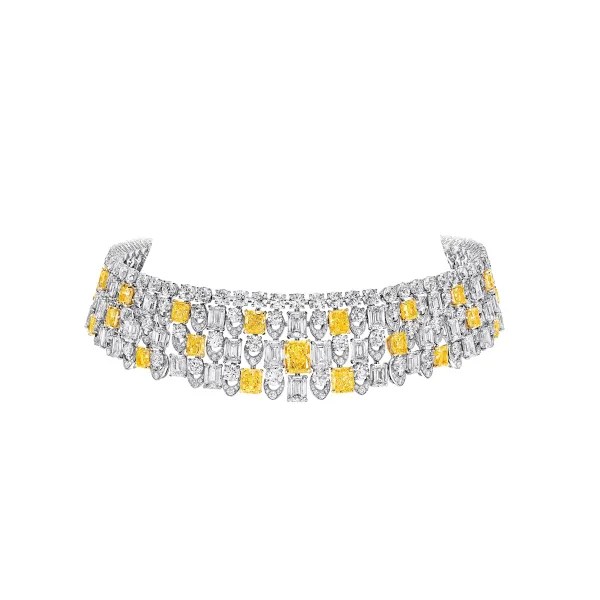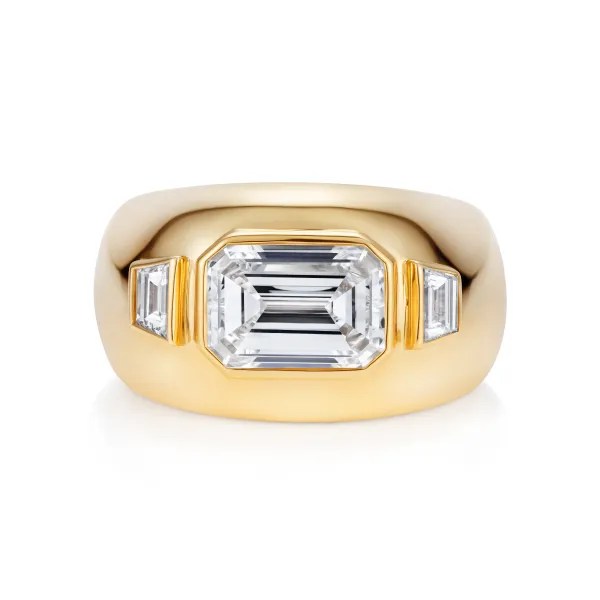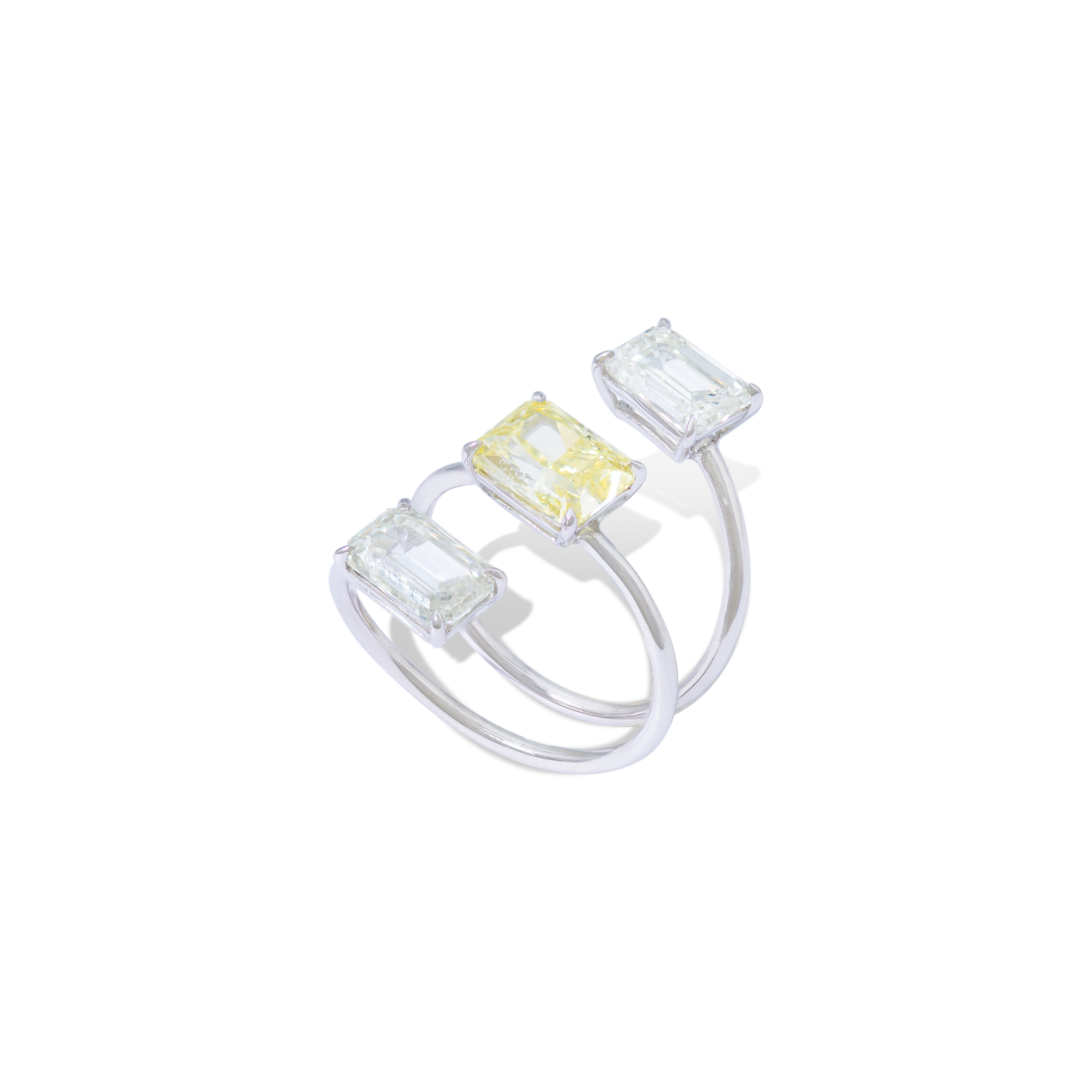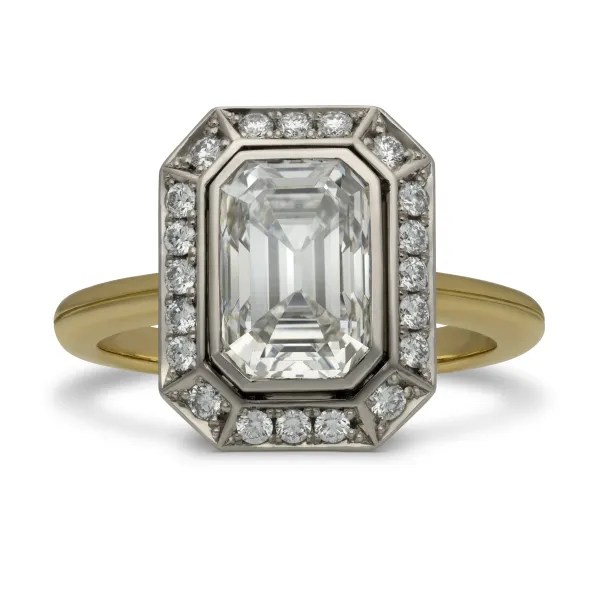Everything You Need To Know About Emerald-Cut Diamonds
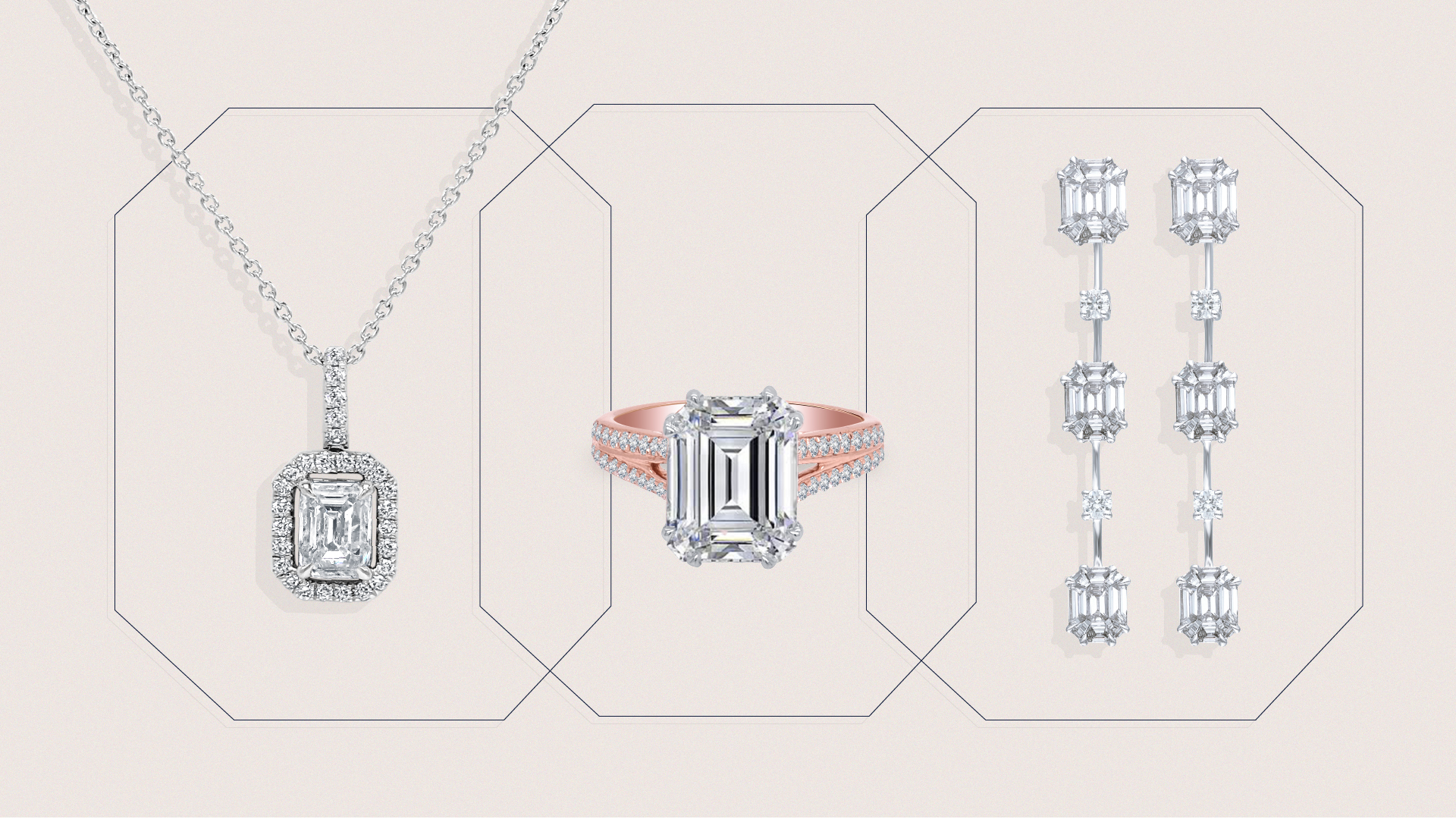
Grace Kelly. Elizabeth Taylor. Victoria Beckham. Deepika Padukone. Amal Clooney. Jennifer Lopez (several times over). Some of the world’s most stylish women have worn emerald-cut diamond engagement rings. With their rectangular silhouette, large open table and step-cut facets, emerald-cut diamonds radiate icy elegance; they have a cool, understated demeanour that sets them apart from the flashy, fiery dazzle of a brilliant-cut diamond.
“I love the crisp, uncompromising geometry of emerald-cut diamonds. They are so clean, simple and grown up,”says Bear Brooksbank, an independent British jeweller based in East London. “I always think if they were human, they’d be a mature yet exquisitely beautiful woman.”
The Artistry of Perfect Precision in Emerald-Cut Diamonds
Emerald-cut diamonds don’t suffer fools. Their step-cut facets mean there’s nowhere for imperfections to hide. Only the best quality natural rough diamond crystal will be crafted into an emerald-cut diamond. The result is an incredibly sleek, stunning stone that draws you in with its mesmerising play of light, and sophisticated, vintage appeal.
“An emerald-cut diamond has a unique lustre. It’s not just a simple sparkle; it’s more like looking into a clear crystal lake,” says Nishith Shah, CEO of La Marquise Jewellery. “The way it reflects light, and its pure whiteness are unlike any other diamond cut, giving it unique clarity and beauty.”
For Cherry Sahni, co-founder of Diamondtree, the “unique allure and sense of refined beauty” of emerald-cut diamonds brings “a touch of regal elegance to any piece”. She adds that “the best emerald-cut diamonds have impeccable clarity and a balanced cut, making them true works of art.” Read on to discover everything you need to know about these spectacular natural diamonds.
Emerald-cuts evolved from the earliest faceted diamonds
“The emerald-cut can be traced back to the table cut, which was the starting point of the modern-day step cut,” says Guy Burton, director of Hancocks in London, which specialises in antique diamonds. Developed as far back as the 15th century, the table cut evolved into the cuboid cut, a primitive form of an emerald-cut.
As the name suggests, the cut was originally developed for emeralds. The modern-day, rectangular emerald-cut features 49 linear facets and angular cut corners. Over the centuries, the cut has been refined to “celebrate the purity of the diamond,” says Anne-Eva Geffroy, Design Director at Graff. “They are elegant and timeless,” she adds. It is this same elegance, and the sophisticated allure of emerald-cut diamonds that are admired by Fred Mouawad, Co-Guardian of Mouawad. “The elongated, rectangular outline with its bevelled corners exhibits a unique charm. The rectangular facets also enable the light to reflect through the diamond in a gentle and graceful manner. The lustre of the diamond is still strongly present, but with less scintillation than a brilliant cut,” he explains.
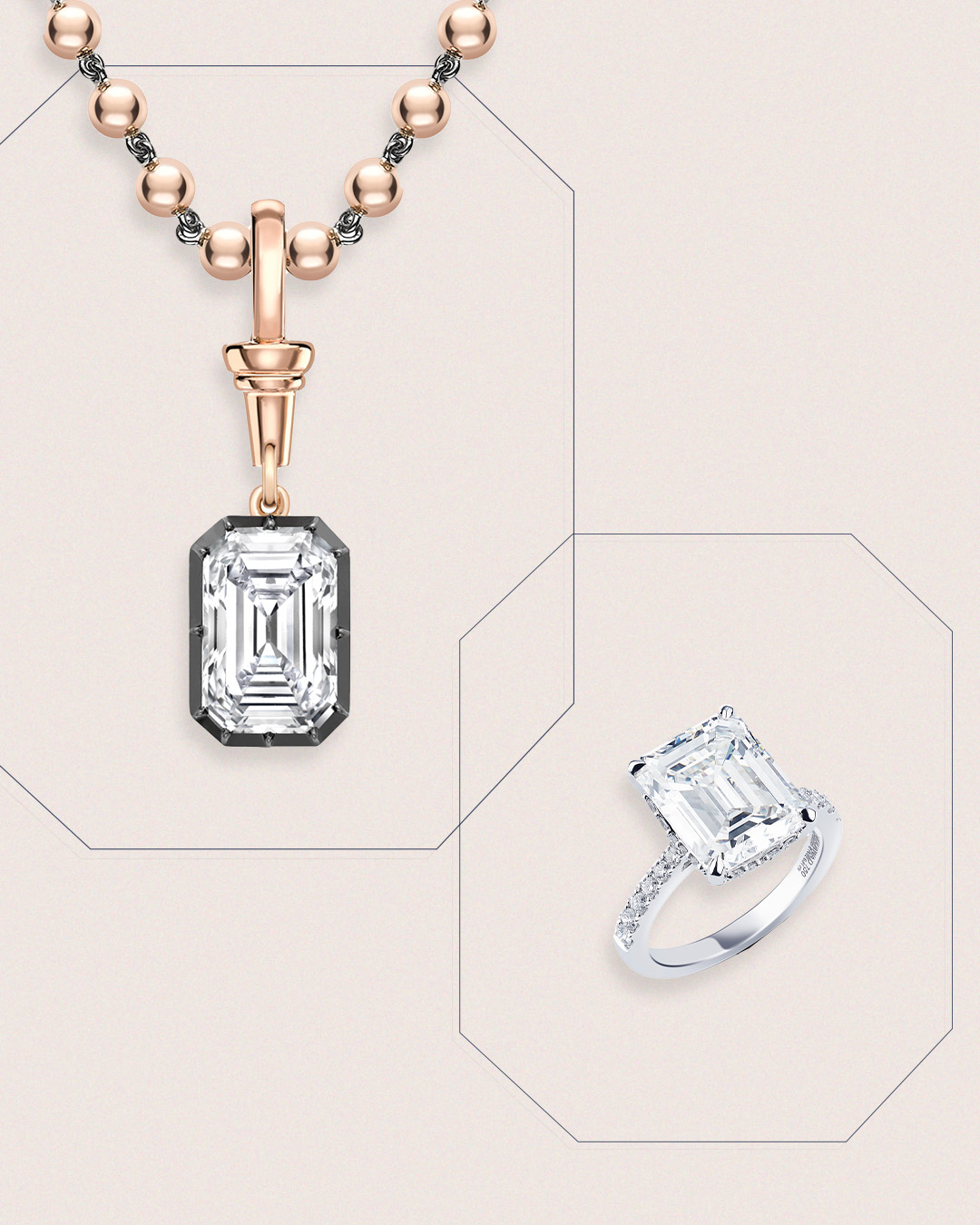
Emerald-cut diamonds rose to fame during the Art Deco era.
With their streamlined silhouette and striking geometry, emerald-cut diamonds are inextricably linked with Art Deco designs of the 1920s and 1930s. Houses such as Cartier, Fouquet and Boucheron popularised these angular stones, often combining the purity of emerald-cut diamonds with black onyx, coral and emeralds, a colour palette that remains sought-after today.
Grace Kelly’s famous 10.48-carat Cartier engagement ring, though created in the 1950s, is typical of the Art Deco style. Prince Rainier of Monaco originally proposed in 1955 with a diamond and ruby eternity ring (the colours of the Monegasque flag), and the couple later selected the monumental emerald-cut diamond to symbolise their fairytale romance. Grace Kelly wore it throughout the film High Society, cementing its place in pop-culture history. The same year, Mike Todd presented Elizabeth Taylor with an astonishing emerald-cut diamond engagement ring weighing almost 30 carats, which she nicknamed her ‘ice-skating rink’. The Princess’ style remains popular today: Mouawad offers an 11.29-carat emerald-cut diamond engagement ring that exudes star quality.
In the 1920s and 1930s, before the advent of digital technology and standardised cutting templates, each stone was uniquely cut to maximise the rough diamond’s natural beauty. “A talented diamond cutter would have worked the raw material to achieve the best aesthetic; they wouldn’t have cared whether it would end up as 1.90 or 2 carats, or whether it was deeper or flatter – they would simply cut it into the most beautiful geometric shape they could achieve,” says Guy Burton, who sources emerald-cut diamonds from this era and sets them into engagement rings which retain a distinctly Art Deco flavour. “In vintage emerald-cut diamonds you tend to see a smaller table with a higher crown and bigger cut corners, which really intensified that angular, geometric feeling. The eye is drawn into the middle of the stone – it’s mesmerising.”
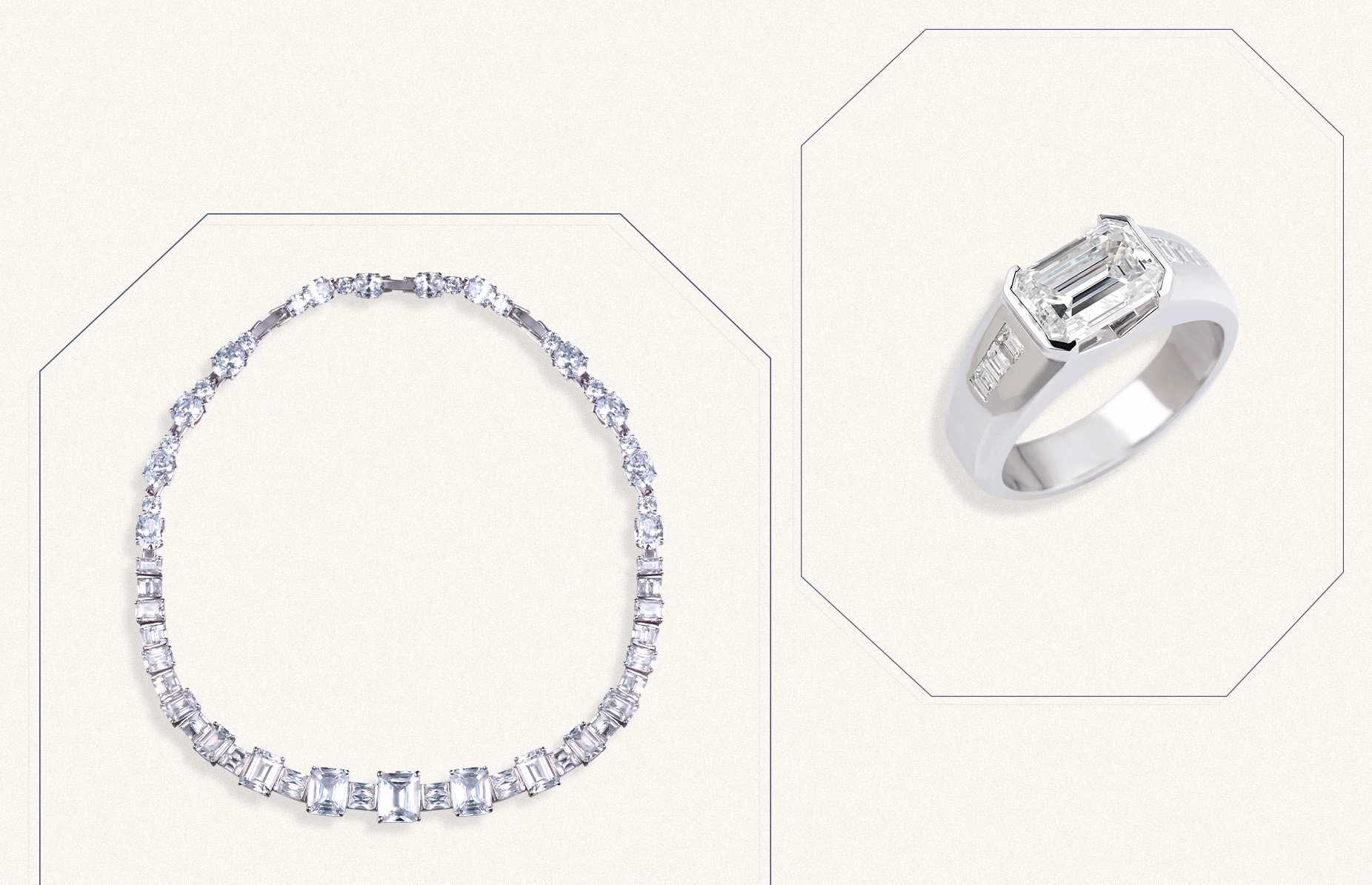
You can’t compromise on clarity.
Of the Four Cs, clarity is the most important when it comes to emerald-cut diamonds. “You can’t compromise on quality [with an emerald-cut] in the way you can with a brilliant or old-cut stone. If there are inclusions, there is nowhere for them to hide,” says Bear Brooksbank, who helps clients to select the best diamond for her bespoke creations. Ashni Kothari, Creative Director of ARAYA Fine Jewelry, recommends buying VVS or VS emerald-cuts, and avoiding SI clarity.
“The long, smooth facets of the emerald-cut leave no room for error, exposing even the tiniest of flaws. A stone of exceptional quality is required to best showcase this beautiful cut,” agrees Graff’s Anne-Eva Geffroy. The British house’s roster of famous emerald-cut diamonds includes the Magnificence, an astonishing 243.96-carat D-colour, Flawless diamond, the world’s largest emerald-cut diamond of that peerless quality, as well as the 118.09-carat Delaire Sunrise, the world’s largest square emerald-cut Fancy Vivid yellow diamond.
What characteristics do all of Graff’s emerald-cut diamonds share? “Excellent proportions, defined step-cuts, a bold rectangular shape and clean lines,” says Geffroy. “A stone with carefully considered facets, crafted by hand and imbued with passion and expertise to reveal its innate, natural beauty – for me, this is perfection.”
Fancy Vivid emerald-cut diamonds are phenomenally rare.
Brilliant-cut facets enhance a diamond’s natural colour, whereas step-cut facets disperse colour, making it appear weaker. When it comes to white diamonds, this means that an emerald-cut stone might appear ‘whiter’ than the colour on its certificate suggests – meaning buyers who want to maximise their budget should opt for a lower colour grade but higher clarity.
In the world of Fancy Coloured diamonds, brilliant-cut facets are often used to intensify a stone’s colour and achieve coveted ‘Vivid’ status. Only diamonds with the infinitely rare combination of remarkable natural saturation and exceptional clarity will be crafted into emerald-cuts, which makes them truly phenomenal occurrences. Such rare treasures of nature include the 18.96-carat Pink Legacy, which the house of Harry Winston purchased at auction for $50.3 million in 2018; the 15.10-carat De Beers blue diamond, which sold for $57.4 million in April 2022; and the 14.62-carat Oppenheimer Blue diamond, which achieved $57.8 million in 2016, setting a world record for the most expensive gem ever sold at auction. Beyond the realm of the auction rooms, to see a Fancy coloured diamond crafted into an emerald-cut means the natural stone is a truly remarkable specimen.

The perfect ratio is in the eye of the beholder.
Unlike modern-day brilliant-cut diamonds, which follow a strict template for the size and placement of each of their facets, there is no ‘perfect’ proportion for an emerald-cut diamond; it’s simply a matter of personal taste. Most jewellers opt for a length-to-width ratio of 1.40 to 1.50, although every designer has their own preference.
“To achieve the perfect rectangular shape, I find that a ratio between 1.30 to 1.40 works best,” says Nishith Shah, CEO of La Marquise Jewellery. “If the ratio is too low, it resembles an Asscher cut, and if it’s too high, it resembles a baguette cut.” The house accentuates the crisp corners of its emerald-cut diamonds with a double halo of pavé-set stones in earrings which call to mind the glamour of the Great Gatsby era.
Ashni Kothari, Creative Director of ARAYA Fine Jewelry, prefers “longer and sleeker emerald-cuts,” with a ratio of between 1.50 and 1.60. “The higher the ratio gets, the sleeker the shape is.” The house displays three of these elongated emerald-cuts in a wraparound ring, contrasting two white diamonds with one yellow diamond, each one set East-West (horizontally), to show off its slender proportions.
Depth is also an important factor to take into account. According to Guy Burton, emerald-cuts can look a bit hazy if they are too shallow, and can end up with a dark shadow in the middle if they are too deep. “You have to see the stone in person, because two identical diamonds from the certificate can be two very different looking stones,” he says. Bear Brooksbank also espouses the importance of examining diamonds in real life. “There’s an elusive magic that some diamonds have, and some don’t, and you have to see them in the flesh to know,” she says. “Two diamonds might have the same credentials on paper, but one will just have the edge in terms of its internal life and flair.”
There’s more to emerald-cuts than Art Deco.
Although emerald-cut diamonds are instantly associated with the Art Deco era, contemporary designers are finding new ways to experiment with their angular forms. For instance, Moksh sets emerald-cut diamonds at the centre of bulbous petals of brushed yellow gold in a pair of oversized stud earrings, a whimsical juxtaposition that adds a dose of irreverence to this stately cut.
London-based Jessica McCormack strings emerald-cut diamonds almost casually on her signature Ball n Chain gold necklaces, or combines an elegant emerald-cut with a romantic heart-shaped diamond in her contemporary take on traditional toi et moi rings. Bear Brooksbank likes to set emerald-cut diamonds horizontally, flanked by trapezium-shaped side stones in heavy, Gypsy-style gold rings, while Graff contrasts the clean geometry of emerald-cuts with rhythmic diamond curves in its Tribal collection of earrings and necklaces.

“I’ve always been captivated by the understated elegance of an emerald-cut natural diamond. It’s a testament to nature’s artistry, where each facet reveals a unique story of time and pressure,” says Harshad Ajoomal, Founder and Designer of HJ Ajoomal, who has gathered an impressive collection of emerald-cut diamonds to set in a contemporary spin on a diamond riviere necklace. “We love to use emerald-cut diamonds in designs that celebrate their purity and timeless appeal. To me, the perfect emerald-cut natural diamond balances precision with character, allowing it to shine in any setting.”
